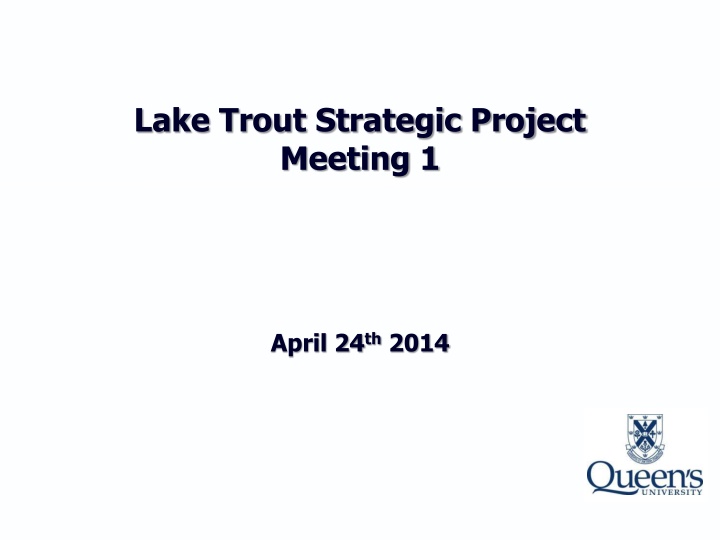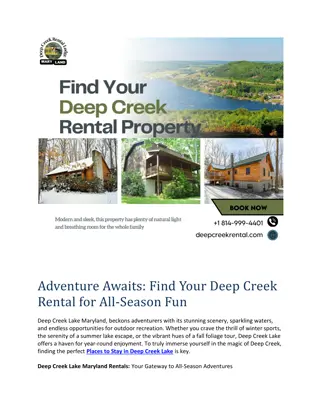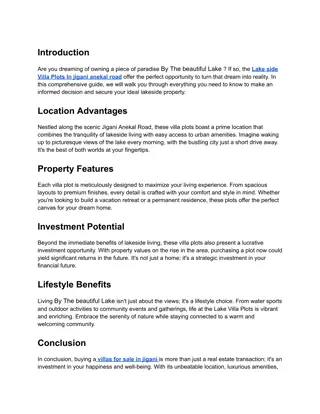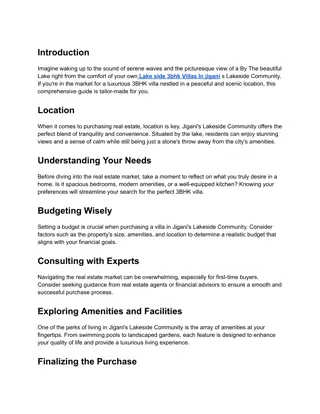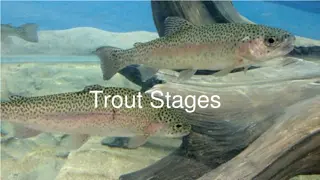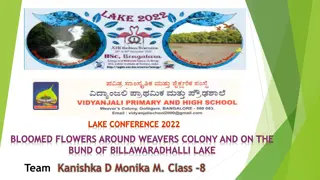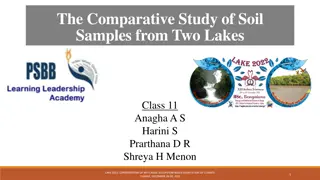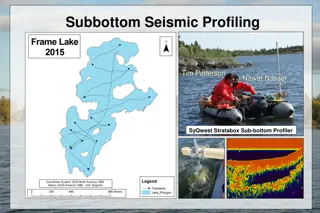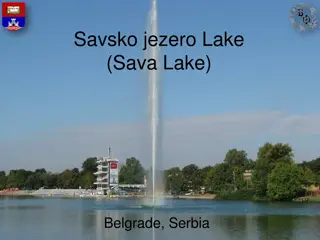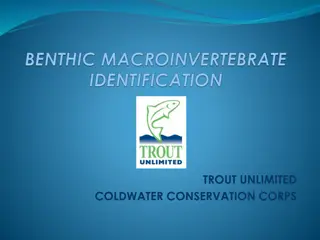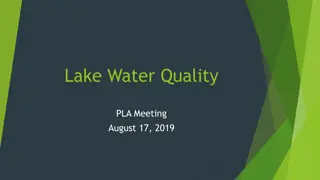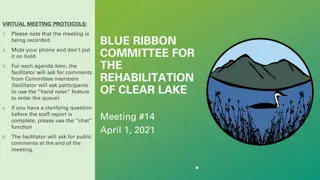Lake Trout Strategic Project Meeting Summary
Lake Trout Strategic Project Meeting held on April 24th, 2014, focused on developing new predictive tools to forecast the impact of climate change on hypolimnetic dissolved oxygen concentrations in Lake Trout lakes of Ontario. The meeting agenda covered project objectives, timeline, communication strategy, budget items, progress reports, and other business. The project overview highlighted three main themes: Understanding the past, Modeling the present, and Forecasting the future. Themes included components like paleolimnology, empirical modeling, and dynamic modeling to support lake and resource managers. The meeting aimed to enhance environmental monitoring and management practices for sustaining Lake Trout populations and ecosystems in the face of anthropogenic influences.
Download Presentation

Please find below an Image/Link to download the presentation.
The content on the website is provided AS IS for your information and personal use only. It may not be sold, licensed, or shared on other websites without obtaining consent from the author.If you encounter any issues during the download, it is possible that the publisher has removed the file from their server.
You are allowed to download the files provided on this website for personal or commercial use, subject to the condition that they are used lawfully. All files are the property of their respective owners.
The content on the website is provided AS IS for your information and personal use only. It may not be sold, licensed, or shared on other websites without obtaining consent from the author.
E N D
Presentation Transcript
Lake Trout Strategic Project Meeting 1 April 24th 2014
Agenda Project Objectives Summary of what we promised Timeline and Milestones Short, medium and long-term Communication Strategy Budget Items Progress of the paleo group Other Business
Project Objective To develop new predictive tools for forecasting the impact of climate change and other anthropogenic activities on hypolimnetic dissolved oxygen concentrations in Lake Trout lakes of Ontario
Project Overview Theme 1: Understanding the past Theme 2: Modeling the present Theme 3: Forecasting the future Develop and calibrate models on a common set of study lakes Apply models to lakes of significant interest to supporting organizations New toolset for lake and resource managers
Theme 1 Paleolimnology Provide lake managers with detailed paleolimnological reconstructions of hypolimnetic [DO], TP, lake production, DOC, and climate variables for the strategically selected study lakes. The paleoenvironmental data will be used by the project s modelers to validate broad-scale environmental drivers of historic [DO]. The relationships between [DO] and its drivers in the paleo data sets will be compared to those from both empirical and computational lake models.
Theme 2 Empirical Model New model developed using 1999-2010 data before generating results to compare with recent paleolimnological data and the dynamic 1D model. Empirical model rebuilt to include lake [DOC] as an independent variable in addition to TP. Predictions of end-of-summer [DO] profiles will be transformed into volume-weighted hypolimnetic DO and compared with paleo reconstructions and dynamic model predictions from recent years. Revised model will be applied to several inland lakes at high risk of cyanobacteria blooms
Theme 3 Dynamic Model A 1D (vertical) model will be developed to simulate physics and biogeochemistry over timescales relevant to future climate change. Model predictions will be validated against historical lakewater observations ( A lakes) and paleolimnological data. The technology developed will be transferred to Environment Canada who have already embedded the 1D hydrodynamic submodel within their Canadian Land Surface Scheme, General and Regional Climate Models (GCMs) and Numerical Weather Prediction models.
Theme 3 Dynamic Model We will couple the 1D hydrodynamic Environment Canada model to the biogeochemistry algorithms from DYRESM-WQ and develop the coupled model for a Canadian setting that incorporates ice cover and is fully coupled to the Environment Canada weather and climate prediction models. We will develop an empirical sediment oxygen demand (SOD) model, for the new dynamic 1D model, from the paleolimnological data time- history of organic matter accumulation in the sediments and reconstructed [DO].
Theme 3 Dynamic Model The dynamic model simulations will be calibrated and validated against the 35 year DESC A lake data set. The simulated data will be of higher space-time resolution than the A lake data, and so will be used to aid development of the empirical model. The dynamic model will be coupled to Environment Canada GCM hindcasts to simulate broad-scale modeled trends during past climatologies (e.g., pre-industrial ~1850 AD) and the results will be compared to the paleoenvironmental data .
Timeline/Milestones (Short term) Milestone 1. Recruit graduate students and PDF 2. Project orientation and data collection Description Start Finish 2013-Dec-16 Theme1 PDF and PhD1; Theme2 MSc; Theme3 PhD2 Study of field sites, long-term datasets and existing models, learn and develop methodologies Initial workshop/data sharing meeting 2013-Oct-15 2014-Jan-01 2014-Jul-01 3. Workshop 1 2014-Apr-01 2014-Apr-01 4. Field Season 1 Collection of sediment cores from the study lakes located in Eastern and Central Ontario (PDF, PhD1) Couple 1D physical and biogeochemical models (PhD2) Analyze in Field Season 1 sediments for invert remains, spectral signatures, radioisotopes (PDF), diatoms (PhD1). Test original empirical model for predicting end-of-summer oxygen profiles with current data (MSc) 2014-Apr-01 2014-Sep-01 5. Coupling of 1D models 6. Sediment Analysis 2014-Apr-01 2015-Jul-01 2014-Jul-01 2016-Jan-01 7. Test original empirical model 2014-Jul-01 2014-Oct-01
Timeline/Milestones (Medium term) Milestone 8. Transfer paleo data Description Start Finish 2015-Oct-01 Transfer of paleo data to modelling groups as analyses of individual sediment cores are completed (PDF, PhD1) Workshop/data sharing meeting at Queen s all PI s and partners MSc will revise empirical model using 1999-2010 data including DOC as an independent variable PhD2 wil develop carbon based predictive SOD model from paleo cores and validate models against long-term DESC data sets. Workshop/data sharing meeting at one of the research or partner hubs; all PI s and partners. Collection of sediment cores from Lake of the Woods and Lake Manitou (PDF, PhD 1) 2014-Sep-01 9. Workshop 2 2014-Oct-01 2014-Oct-01 10. Revision of empirical model 2014-Oct-01 2015-Apr-01 11. Development of SOD model and validation of 1D model 2014-Oct-01 2015-Oct-01 12. Workshop 3 2015-Apr-01 2015-Apr-01 13. Field Season 2 2015-Apr-01 2015-Sep-01
Timeline/Milestones (Medium term) Milestone 14. Validation of revised empirical model Description Start Finish 2015-Oct-01 MSc will validate and compare the revised empirical model with the long- term observational data, paleo reconstructions and 1D dynamic model MSc will apply the revised empirical model to several inland lakes at risk of cyanobacteria blooms Validation of the dynamic models against long-term observation datasets and paleo reconstructions (TP, DO, DOC), (PhD2, PDF, PhD1) Workshop/data sharing meeting at one of the research or partner hubs; all PI s and partners. Workshop/data sharing meeting at one of the research or partner hubs; all PI s and partners. 2015-Apr-01 15. Application of revised empirical model 16. Validation of dynamic models 2015-Jul-01 2015-Oct-01 2015-Jul-01 2016-Apr-01 17. Workshop 4 2015-Oct-01 2015-Oct-01 18. Workshop 5 2016-Apr-01 2016-Apr-01
Timeline/Milestones (Long term) Milestone 19. Application of dynamic models Description Start Finish 2016-Dec-31 Apply models to predict future [DO] in lake trout lakes under climate change scenarios (PhD2) Synthesize paleolimnological information (chironomids, diatoms, radioisotopes) to examine relationship among [DO], algal blooms, nutrient, climate, and/or other environmental factors. Final workshop/data sharing meeting; user sector workshop. 2016-Apr-01 20. Paleolimnological synthesis 2016-Jul-01 2016-Dec-31 21. Workshop 6 2016-Oct-01 2016-Oct-01
Communication Strategy PI s, Government, LotW/FOCA Website (papers, presentations, etc.) Avoid detail fatigue in partners
Theme 1 Progress (Paleo) Sediments: Harp Lake Red Chalk Lake Charleston Lake Eagle Lake Limerick Lake Loughborough Lake Muskrat Lake Lake Manitou Lake of the Woods Collected August 2013 Will be collected summer 2014 Will be collected fall 2014/ summer 2015
Theme 1 Progress (Paleo) Harp and Red Chalk sediment cores both dated (RC ~Half of Harp chironomid counts complete Clare starts May 1st and will begin diatom analysis immediately
